Know Your Metal – Gold, Silver & Diamond Purity Guide
1) GOLD PURITY GUIDE
Gold’s purity is measured in karats. Karat is the unit used to measure the purity of gold. The higher the karat in gold items, the purer the gold. Be it molded into coins or precious jewellery, gold is available in various karats used differently.
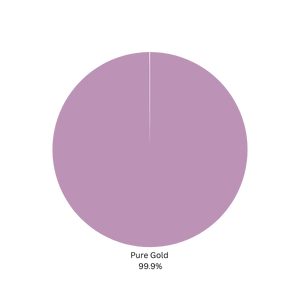
24K GOLD
99.9% Pure Gold
Pure gold composed of 99.9% gold with minimal other metals. This is the highest quality and most valuable type. Soft and easily bendable, not suitable for regular jewellery but ideal for coins, bars, electronics, and medical devices.
Hall Mark Identification: marked with 999
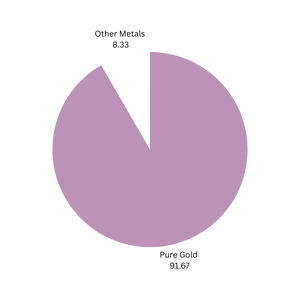
22K GOLD
91.67% Pure Gold
An alloy with 22 parts gold and 2 parts other metals, usually copper and silver. Valued for durability and rich, warm color. 22-karat gold jewellery is ideal for regular wear purposes. However, it is not ideal for making heavy gold jewellery with diamonds and other gemstones.
Hall Mark Identification: marked with 916
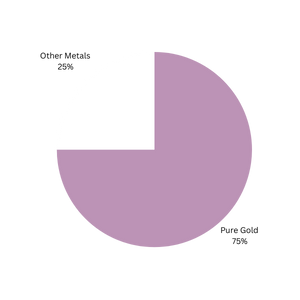
18K GOLD
75% Pure Gold
Contains 18 parts gold and 6 parts other metals like silver, copper, and zinc. Highly suitable for studded and diamond jewellery. Has a rich yellow tone with a slightly dull shade. Perfect for engagement rings and wedding bands.
Hall Mark Identification: marked with 750
14K GOLD
58.3% Pure Gold
Made with 58.3% pure gold and 41.7% other metals. More affordable with a paler yellow color. Higher amount of alloyed metals makes it resistant to wear and tear, ideal for daily-wear jewellery, especially for active lifestyles.
Hall Mark Identification: marked with 585
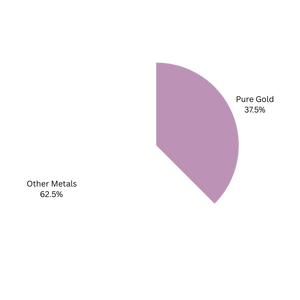
9K GOLD
37.5% Pure Gold
The most affordable option with 37.5% gold and 62.5% other alloys. Sturdy, doesn’t scratch or bend easily. Has a paler tone and is used for simple chains and rings. May cause skin irritation for those allergic to certain metals.
Hall Mark Identification: marked with 375
WHICH KARAT IS BEST?
There is no “best” type of gold for everyone. It depends on the jewellery type and how often you’ll wear it. Consider factors like skin sensitivity, lifestyle, aesthetic preference, and budget when choosing gold jewellery.
2) STERLING SILVER GUIDE
Sterling silver is an alloy of silver containing 92.5% pure silver and 7.5% other metals, usually copper. This addition makes the otherwise soft silver more durable and suitable for jewellery and decorative items.
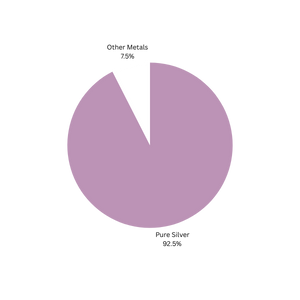
STERLING SILVER (925)
92.5% Pure Silver
The standard of silver that is most commonly used in jewellery. The “925” stamp indicates 92.5% pure silver content. Sterling silver is durable enough for everyday wear while maintaining the lustrous beauty of silver. It may tarnish over time but can be easily cleaned and maintained.
CARING FOR STERLING SILVER
Store in a cool, dry place away from sunlight and humidity. Use anti-tarnish strips or bags. Clean with a silver polishing cloth. Avoid exposure to chemicals like chlorine, bleach, and sulfur. Remove jewellery before swimming, bathing, or using household cleaners.
3) DIAMOND PURITY GUIDE
Diamond quality is determined by the 4Cs: Carat (weight), Clarity (purity), Color (absence of color), and Cut (how well it’s cut). All four factors together determine a diamond’s value and beauty.
Diamond Clarity:
Diamond purity is measured by its clarity, which refers to the absence of inclusions and blemishes. The Gemological Institute of America (GIA) grading scale is the industry standard for diamond clarity.
FLAWLESS (FL) & INTERNALLY FLAWLESS (IF)
No inclusions or blemishes visible under 10x magnification. Extremely rare and valuable. Internally Flawless may have minor surface blemishes but no internal inclusions.
VERY, VERY SLIGHTLY INCLUDED (VVS1 & VVS2)
Contains minute inclusions that are difficult for a skilled grader to see under 10x magnification. These inclusions are invisible to the naked eye and do not affect the diamond’s brilliance.
VERY SLIGHTLY INCLUDED (VS1 & VS2)
Contains minor inclusions that are somewhat easy to see under 10x magnification but still invisible to the naked eye. Popular clarity grades that offer excellent value.
SLIGHTLY INCLUDED (SI1 & SI2)
Contains inclusions that are noticeable under 10x magnification. SI1 inclusions are typically not visible to the naked eye, while SI2 may have inclusions visible to the naked eye upon close inspection.
INCLUDED (I1, I2 & I3)
Contains inclusions that are obvious under 10x magnification and may affect transparency and brilliance. These inclusions are often visible to the naked eye and may impact the diamond’s durability.
Everything You Need to Know About Diamond Carat
Diamond carat weight is one of the most important aspects when it comes to purchasing a diamond. While many people believe that carat refers to the size of the diamond, it actually measures the weight of the diamond. One carat equals 200 milligrams (0.2 grams), and this measurement plays a significant role in determining the diamond’s value. The higher the carat weight, the rarer and more valuable the diamond tends to be. However, a diamond’s beauty and brilliance is determined by more than just carat weight; the cut, clarity, and color are just as important.
Understanding Carat Weight and Diamond Size
When shopping for diamonds, it’s crucial to understand that carat weight does not directly equate to the physical size of the diamond. A well-cut diamond with a smaller carat weight can appear larger than one with a higher carat but a poor cut. The diamond cut affects how the light interacts with the stone, creating sparkle and visual appeal. This is why a 1-carat diamond may look different in size depending on its shape (round, oval, cushion, etc.) and proportions.
How Carat Weight Affects Diamond Value
The weight of the diamond significantly impacts its price. Larger diamonds are much rarer and harder to find, driving up their diamond value. However, it’s important to note that diamonds of equal carat weight can vary in price based on factors like diamond cut quality and diamond clarity. For instance, a flawless diamond with a higher carat weight will generally cost more than one that is slightly imperfect.
Total Carat Weight (TCW)
- When purchasing jewelry with multiple diamonds, you’ll come across the term Total Carat Weight (TCW). This refers to the combined carat weight of all diamonds in a piece of jewelry. For example, a diamond ring with several smaller diamonds may have a total carat weight of 1 carat, even though each stone is less than 1 carat.
What’s Diamond Cut? The Secret to Brilliance and Sparkle
The diamond cut is one of the most important characteristics of a diamond. It refers to how well a diamond has been shaped and faceted, and it plays a critical role in determining the diamond’s brilliance, fire, and overall sparkle. Unlike other diamond attributes such as color or carat weight, the cut is not about the stone’s size but how well it interacts with light.
A well-cut diamond will reflect light from one facet to another, creating a dazzling sparkle that makes the diamond visually appealing. On the other hand, a poorly cut diamond may appear dull, even if it has a high carat weight and perfect color. The diamond cut quality is, therefore, crucial when selecting the perfect diamond.
The Importance of Diamond Cut Quality
The diamond cut quality is often graded on a scale that includes the following categories:
- Excellent Cut: Diamonds in this category reflect the most light and have maximum brilliance.
- Very Good Cut: These diamonds reflect light very well but may not be as sparkly as the excellent cut diamonds.
- Good Cut: Diamonds in this range show some sparkle, but they don’t exhibit the brilliance of higher-cut diamonds.
- Fair Cut: Diamonds with a fair cut often have poor light reflection, leading to a more dull appearance.
- Poor Cut: These diamonds tend to appear lifeless due to poor symmetry and light reflection.
How Diamond Cut Affects Its Appearance and Value
The cut of the diamond can influence its overall appearance in many ways:
- Brilliance: A well-cut diamond will reflect light better, making it sparkle more.
- Fire: Fire refers to the colorful flashes of light that come from the diamond when it is exposed to light. A high-quality cut maximizes the fire of the diamond.
- Scintillation: This refers to the diamond’s sparkle, which is enhanced by its cut. The more facets the diamond has, the more light it can reflect, increasing scintillation.
Diamond Shapes and Cuts
It’s important to note that diamond shapes (such as round, princess, emerald, cushion, and others) are different from the cut quality. A round cut diamond is one of the most popular and brilliant diamond cuts due to its symmetry, while other shapes may offer different visual effects.
Understanding Diamond Color
When it comes to purchasing a diamond, diamond color is one of the most essential factors that affects its appearance and value. The color of a diamond refers to the presence of any color in the stone, with diamonds being graded on a scale that ranges from D (colorless) to Z (light yellow or brown). Diamonds that are completely colorless are the most desirable and valuable, as they allow more light to pass through, resulting in maximum sparkle and brilliance. While diamond color grading is an important factor to consider, it’s crucial to remember that the color scale only applies to white diamonds. For colored diamonds (like blue diamonds, pink diamonds, or yellow diamonds), the color is more of a feature that enhances their value, and the color grade is more about intensity and hue rather than the absence of color.
The Diamond Color Grading Scale
The diamond color grading scale is used to assess the presence of any color in a diamond. Here’s a quick guide to the scale:
- D-F (Colorless): The highest grade of diamonds. These diamonds are entirely colorless and allow the maximum amount of light to pass through.
- G-J (Near Colorless): These diamonds are slightly less colorless but are still very near to being colorless and can appear white to the naked eye.
- K-M (Faint Yellow or Brown): These diamonds have a subtle tint of yellow or brown, which may be more visible in larger stones.
- N-Z (Light Yellow or Brown): These diamonds are noticeably yellow or brown and are less expensive due to the noticeable color.
How Diamond Color Affects Value
The diamond color grade directly impacts the price of the diamond. Colorless diamonds (D-F) are considered rare and are typically priced higher. However, diamonds with slightly lower color grades (G-J) can still appear nearly colorless to the naked eye and offer great value for money.
Tips for choosing the right metal and gemstone:
- If you have sensitive skin, consider higher karat gold (18K+) or platinum as they contain fewer alloys that might cause allergic reactions.
- For everyday wear jewellery, 14K gold offers the best balance of durability and value.
- Sterling silver is an affordable alternative to white gold but requires more maintenance to prevent tarnishing.
- For diamond jewellery, VS1-VS2 clarity offers the best value as inclusions are not visible to the naked eye.
- Always check for proper hallmarks and certifications when purchasing precious metals and gemstones.
